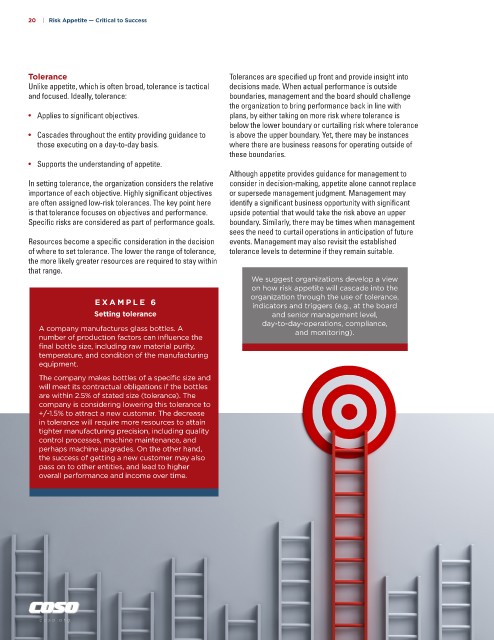Page 492 - COSO Guidance
P. 492
20 | Risk Appetite — Critical to Success
Tolerance Tolerances are specified up front and provide insight into
Unlike appetite, which is often broad, tolerance is tactical decisions made. When actual performance is outside
and focused. Ideally, tolerance: boundaries, management and the board should challenge
the organization to bring performance back in line with
• Applies to significant objectives. plans, by either taking on more risk where tolerance is
below the lower boundary or curtailing risk where tolerance
• Cascades throughout the entity providing guidance to is above the upper boundary. Yet, there may be instances
those executing on a day-to-day basis. where there are business reasons for operating outside of
these boundaries.
• Supports the understanding of appetite.
Although appetite provides guidance for management to
In setting tolerance, the organization considers the relative consider in decision-making, appetite alone cannot replace
importance of each objective. Highly significant objectives or supersede management judgment. Management may
are often assigned low-risk tolerances. The key point here identify a significant business opportunity with significant
is that tolerance focuses on objectives and performance. upside potential that would take the risk above an upper
Specific risks are considered as part of performance goals. boundary. Similarly, there may be times when management
sees the need to curtail operations in anticipation of future
Resources become a specific consideration in the decision events. Management may also revisit the established
of where to set tolerance. The lower the range of tolerance, tolerance levels to determine if they remain suitable.
the more likely greater resources are required to stay within
that range.
We suggest organizations develop a view
on how risk appetite will cascade into the
organization through the use of tolerance,
EX AMPLE 6 indicators and triggers (e.g., at the board
Setting tolerance and senior management level,
day-to-day-operations, compliance,
A company manufactures glass bottles. A and monitoring).
number of production factors can influence the
final bottle size, including raw material purity,
temperature, and condition of the manufacturing
equipment.
The company makes bottles of a specific size and
will meet its contractual obligations if the bottles
are within 2.5% of stated size (tolerance). The
company is considering lowering this tolerance to
+/-1.5% to attract a new customer. The decrease
in tolerance will require more resources to attain
tighter manufacturing precision, including quality
control processes, machine maintenance, and
perhaps machine upgrades. On the other hand,
the success of getting a new customer may also
pass on to other entities, and lead to higher
overall performance and income over time.
c oso . or g

